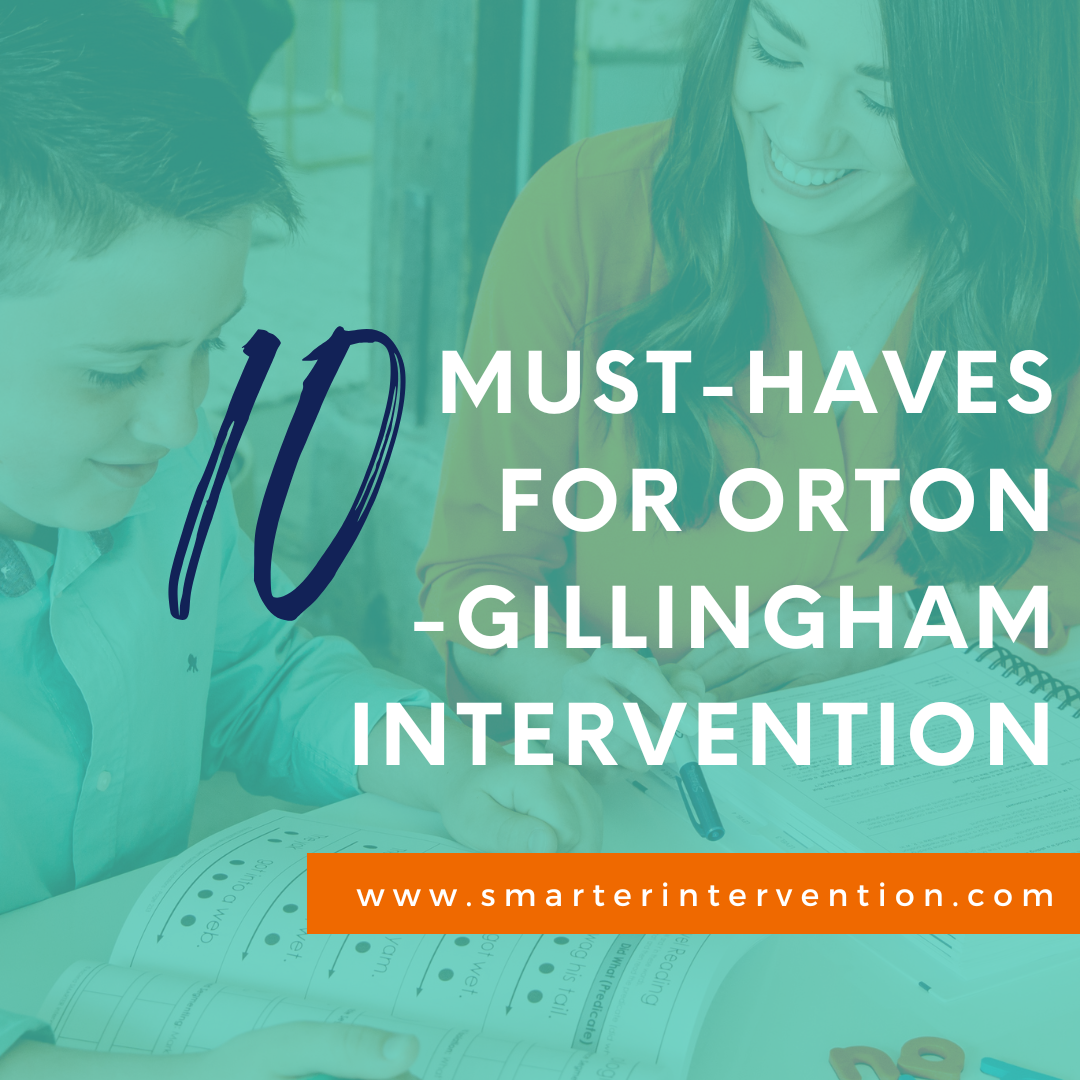Science-based literacy resources and articles
for families, educators and schools
Search by Category:
Categories
- Advocacy
- Authentic Literature
- Business
- Comprehension
- Data Tracking
- Differentiation
- Dyslexia
- Evaluation and Assessment
- Executive Functioning
- Games & Activities
- Helping My Child At Home
- How To
- IEP/504 Plan
- Lesson Planning
- Math
- Online Intervention
- Organization
- Parents
- Phonics
- Phonological Awareness
- Reading Comprehension
- Reading Fluency
- Research
- SLP
- Spelling
- Vocabulary
- Writing
10 Must Haves for Orton-Gillingham Intervention
So I don't know about all of you, but when I started out delivering OG intervention I was trying to figure what supplies and materials I absolutely needed for my classroom and small group intervention. I knew I would need writing materials, reading supplies, games, activities, word lists, the list went on and on. We’ve put together a list of Orton-Gillingham necessities to help make your life a little easier!
All About Graphic Organizers
Graphic organizers are visual displays and incredible tools to help your students with writing and comprehension. Graphic organizers can also be called mind maps, concept maps, or concept webs, but they all have the same wonderful purpose - to solidify comprehension. Graphic organizers explicitly teach students how to connect and organize information. They visually show what information to prioritize as well as help students with brainstorming and connecting any background information.
Back to School: How to Prepare for In-Person or Virtual Reading Intervention This Year
It’s that time of year again - back to school. In the weeks that are usually filled with fresh school supplies, neatly organized classrooms/offices, excitement and butterflies, this year seems off. Whether you are returning to school in-person, students are returning in a hybrid-model, or you are seeing students completely virtually, for many, this back-to-school season has been nothing short of confusing and frustrating.
In order to hopefully make your transition into this school year a bit less overwhelming, we wanted to share 3 secrets that will help you be prepared for whatever this year throws your way.
Teaching 1st Grade Reading Online
Today we wanted to talk about how to teach reading to students who are not able to interact on the screen with you. Our goal is always to have engaging and interactive sessions for our reading intervention students. However, there may be times where that just isn’t possible because they may be using a device that doesn’t have that functionality (such as a Google Chromebook), or you may be working from a system (such as Google Hangouts) that doesn’t allow students to control your screen.
Why We Love Interactive Notebooks in Our Reading Intervention
One of our favorite things to do with our students is to create interactive notebooks. We absolutely love it because it is a really great way to start off your systematic, structured, reading intervention. It's also a great way to keep students engaged!
7 Must Haves for Research Based Reading Intervention
Whether you are a teacher, a parent, an SLP, or an interventionist, if you’re anything like us…which you are, because you’re here, you care about providing top notch intervention or instruction for your students. However, with all the differing opinions out there in the field of education it can be difficult to know if what you’re doing is the right thing. Click through to read about our 7 Must Haves for effective, research-based reading intervention.
We Completely Misunderstood Multi-sensory Instruction...
Multisensory teaching is a popular concept in research-based reading instruction, but the problem is that most teachers, interventionists, specialists (including US!) completely misunderstand what is needed to create multisensory reading and spelling instruction. We will show you the most effective and easiest way to incorporate multisensory instruction without the mess!
How YOU Can Work SMARTER Not Harder
We’re sure that you have heard it before. “You should be working smarter, not harder!” It’s a fairly common expression that most people use to help motivate them to be more efficient and stop fumbling around in their work… but it’s more than that. These are the 7 steps you need to work “SMARTER” in your intervention and finally start seeing the results you have been wanting.
Using an Anchor to Help Your Students Cement What They Are Learning
If you have been keeping up with our blogs, you will know that all this month we are talking about ways we can help cement strategies for our students who just aren't getting it. If you are new to our blog, welcome! You can catch up on our last two posts here: 3 Ways to Generalize Skills Learned in Isolation and Is it Just My Kids, Or...
Important Foundations for Successful Reading & Writing: Phonological Awareness
We wanted to dive into some of the core components of literacy (reading and writing) in order to help you, as parents, continue to support your children in developing solid literacy foundations at home. We know there is a lot of jargon surrounding the field of education so we want to try and break that down for you.
4 Steps to Evidence-Based Decoding Instruction
There is a lot to providing high quality reading instruction. One of the most important pieces we always want to focus on is providing explicit decoding strategies. Research indicates that explicit instruction is one of the best ways to support our students’ reading ability!
Multi-sensory Reading Explained
Unlock the power of multi-sensory instruction in reading! Discover how to engage sight, hearing, and touch to enhance learning. From air writing letters to spelling dictation, explore practical methods to make reading instruction more effective. Embrace multi-sensory techniques without the fuss – it’s about engaging multiple senses for better comprehension and retention!













